Using Apocalypse World to Outline and Draft Your Own RPG
Here in Part 6, I’m using an Ursula K. LeGuin quote — you probably already know the one! — as an outline for alternative models to Apocalypse World’s model of conflict.
This article was made possible by the generous support of my patrons. Please consider joining them by supporting me on Patreon.
Here’s What
Apocalypse World offers a powerful, flexible framework you can use to outline, draft, and potentially finish your own roleplaying games. Dozens of creators, both experienced designers and first-timers, have used it with great success, and you can too. It’s not a game system as such, it’s an approach to game system design. It’s easy, and it’s a reliable way to get your creative vision quickly into a playable form.
Reminder: The Goal is to Create a Playable Outline
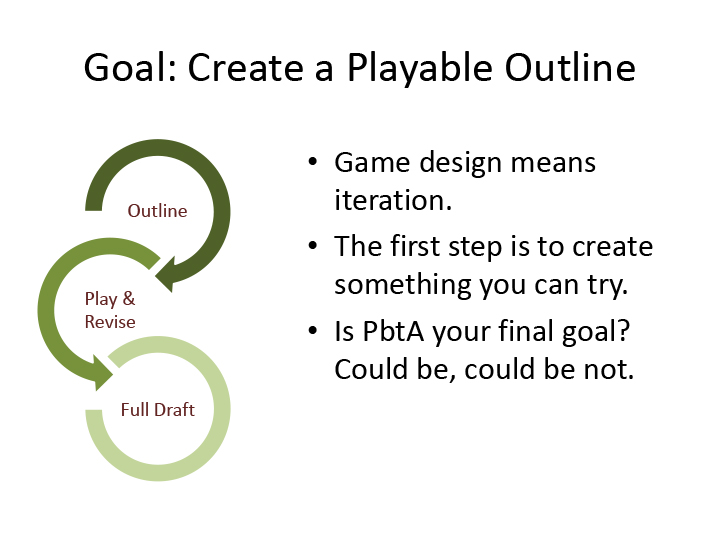
1. Apocalypse World’s Underlying Model
Apocalypse World’s design is based on a model of conflict between characters. It holds that when your character’s vision, best interests, or survival instinct is at odds with someone else’s — the usual state of affairs in Apocalypse World — with time, and given that both you and they have the means to pursue your interests, you’ll come into conflict and ultimately have to resolve it. You’ll resolve it either by setting the conflict aside and coming to an agreement, or by coming to violence instead.
Apocalypse World’s design elaborates this model into its systems of basic moves, supporting rules (like the rules for harm, barter, etc), peripheral moves, and playbooks. Every system and rule in the game is designed to clarify the conflicts between the characters, escalate them through consequential action toward agreement or violence, and ultimately resolve them one way or another.
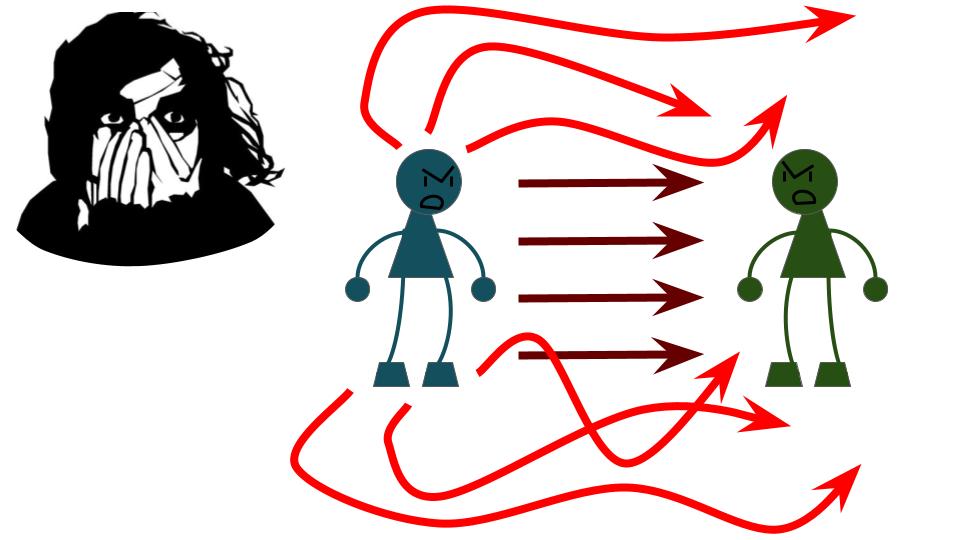
Furthermore, Apocalypse World’s designed to foster and preserve unity of interest between the players even while it creates and escalates conflict of interest between their characters. When your character, through force of action and the workings of the game’s rules, is getting their way in a conflict with my character, it doesn’t mean that you’re getting your way over me in the game. No: we’re working together to choreograph our characters’ conflict.
So far so good, but does this model of conflict underlie PbtA fundamentally too?
No! No it doesn’t.
2. Alternative Models
Here’s Ursula K. LeGuin: “Conflict is one kind of behavior. There are others, equally important in any human life, such as relating, finding, losing, bearing, discovering, parting, changing.“
What would it mean to start with PbtA, but to swap out Apocalypse World’s model of conflict and replace it with…
- A model of relating?
- A model of finding?
- A model of losing?
- A model of bearing?
- A model of discovering?
- A model of parting?
- A model of changing?
How would you design your basic moves so that they don’t create emergent arenas of conflict, but instead create emergent ways of behaving, including conflict as just one among others? So that they don’t (just) clarify and escalate conflict, but clarify and deepen all the ways the characters behave and relate? How would you design your playbooks, what would make this character unique from that character in their ability to relate, their approach to finding and losing, parting and discovering, their capacity to bear and to change?
Come look at this, let me show you something.
3. Under Hollow Hills
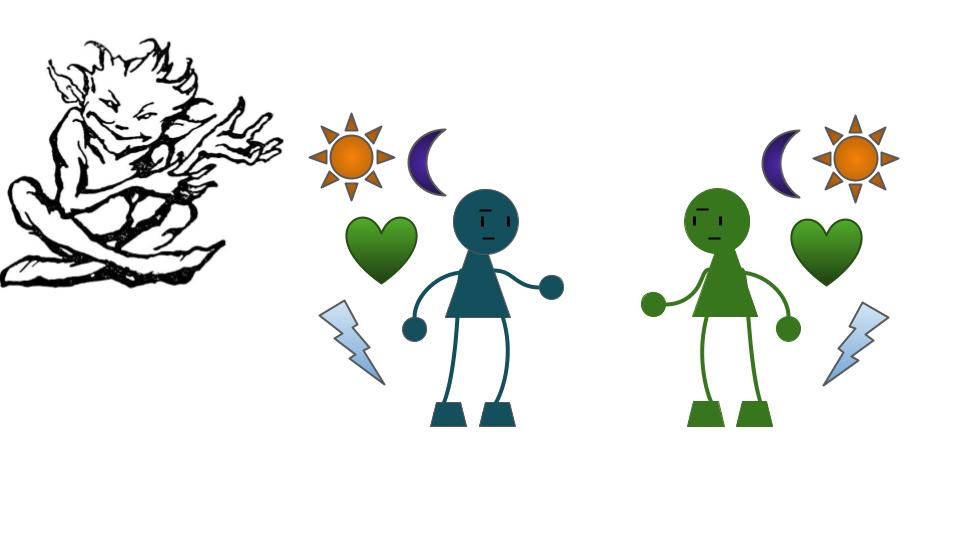
In Under Hollow Hills, your character isn’t a bundle of vision, self-interest, and survival instincts, armored up and armed to the teeth. Instead, your character is a bundle of what do I want? and what do I have to give?
Instead of being in implicit conflict with everyone else in the world, your character is poised to give and receive, to help and be helped, to change others and to be changed by them. Everyone you meet isn’t your enemy or enemy-to-be; everyone you meet is an opportunity to reach out, connect, or discover your own boundaries.
I’ll give an example. Here are two NPC writeups, one for Apocalypse World, one for Under Hollow Hills, for very similar characters. You’ll see at once how Jackabacka the Alpha Wolf is primed for conflict, and Jackie Barren, a Wolf of Winter, is primed for a relationship, of which conflict might be only one part.
Jackabacka is a Warlord, an Alpha Wolf.
Apocalypse World
Her threat impulse is to hunt and dominate.
Her threat moves are:
To outflank, corner, or encircle someone;
To attack someone suddenly, directly, and very hard;
To attack someone cautiously, holding reserves;
To seize someone or something;
To make a show of force or of discipline;
To offer to negotiate, but demand concession or obedience; or
To claim territory.
Jackie Barren is Winter-kind and a Wolf: untamed, beautiful, calculating and hard, full of hunger and self-assurance.
Under Hollow Hills
She craves novelty and the truth.
Her plays are:
To bide her time; or
To corner, press, or encircle someone.
If you please her, she’ll freely give you an invitation to return again; but if you can win it from her, she’ll give you her honest laughter.
In particular, notice how while both will outflank, corner, press, or encircle you, Jackabacka does it to hunt and dominate you — there’s no play there — while Jackie Barren does it for novelty, or — most understandable of reasons — because she wants the truth out of you and you’re holding it back. Even when Jackabacka negotiates, she’s really demanding your obedience; but who wouldn’t hope to win Jackie Barren’s honest laughter?
The same holds for the players’ characters, but of course it’s much more complicated. Let’s take a look.
4. Under Hollow Hills’ Model
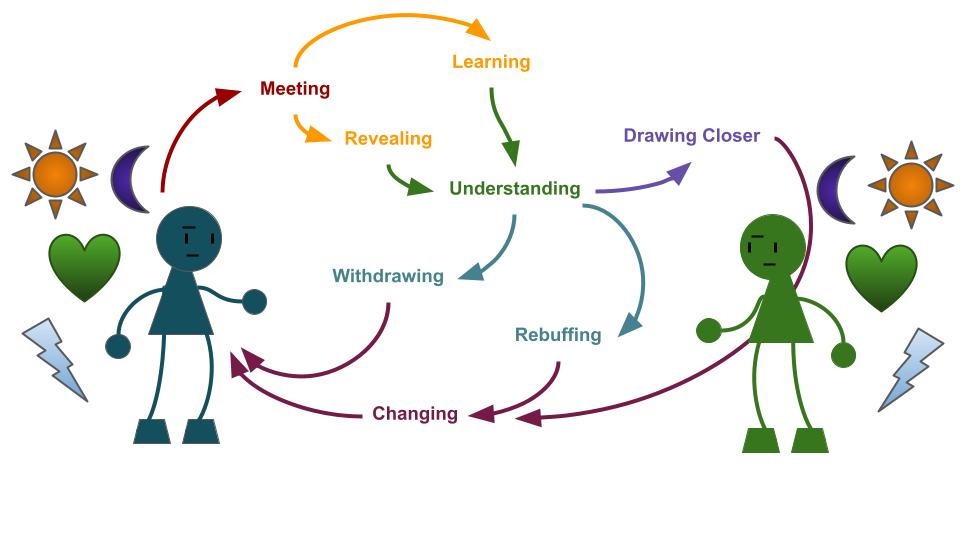
The model Under Hollow Hills is designed on is a relationship cycle. In the broadest strokes, it works like this:
- You meet another character. Maybe you hear about them first. You get and make a first impression.
- Time, circumstances, and inclination allowing, you act both to learn more about them and to reveal more of yourself to them.
- This leads you to a mutual understanding of one another, deeper than your first impressions and first interactions.
- From here you have a choice. You can withdraw from them, rebuff them, or draw closer to them still. They have the same choice too!
- Whichever you choose, this changes you, changes them, and changes your relationship. Furthermore, the circumstances, the place, the season is changing around you. Eventually…
- You learn something new about them, from your changed perspective in your changed circumstances. Maybe you’re surprised, maybe delighted, maybe dismayed, maybe confused or hurt. Maybe they’re sorry and you’re considering giving them another chance. You’ve entered into the cycle again.
No matter how close you come to someone, this model says, because you’re changing, they’re changing, and the world is changing around you, you’re always meeting them anew. There’s always more to learn. There’s always closer you can become, and there’s always the chance — the opportunity or the danger — that you’ll draw apart instead.
This cycle of relationships, not a model of implicit conflict, is the foundation for Under Hollow Hills.
5. Under Hollow Hills’ Basic Moves
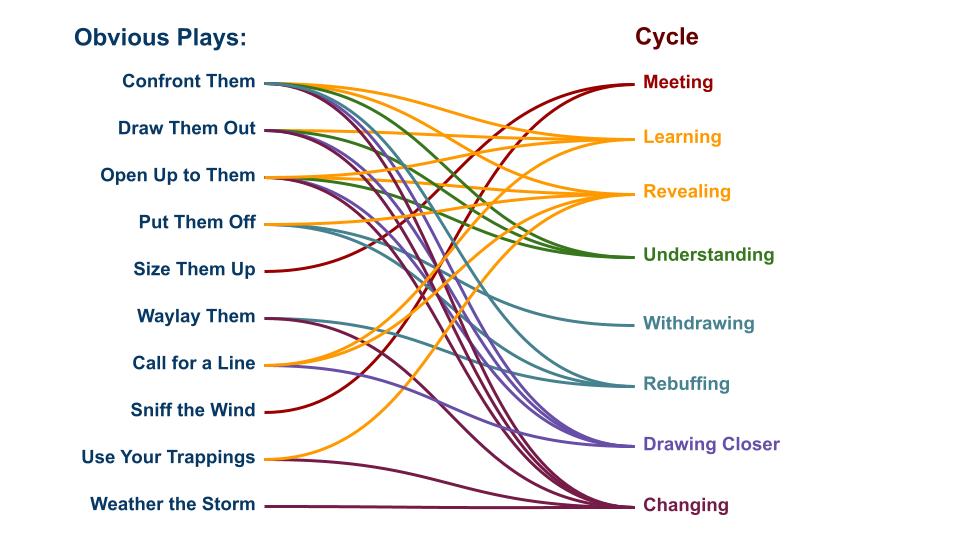
If you recall, Apocalypse World’s basic moves don’t map one-to-one to its arenas of conflict, but apply across them, with some serving more to clarify and escalate conflicts, and others serving more to escalate and resolve them.
It’s similar in Under Hollow Hills — there’s no one-to-one mapping between the basic moves (called “obvious plays” in this game) and the steps in the relationship cycle that underlies them. Instead…
- You might learn about someone by sniffing the wind, and when you first meet them, you might size them up. In fact you might size them up again and again, every time the circumstances change and you’re not sure where they stand.
- In the process of learning more about them and revealing more about yourself, you might confront them, draw them out, open up to them, and/or put them off. When you call for a line, you’ll reveal where you need them, and learn whether you can count on them there. And since your trappings are part of you, using them is revealing too.
- There comes a moment of insight, a realization about your relationship, and a decision to make. This often just happens, but if it happens on a move, it’s likely to be when you confront them, draw them out, or open up to them.
- The most obvious play when you’re withdrawing from someone is to put them off. When you’re rebuffing them, you might confront them or waylay them too.
- Drawing closer to them, on the other hand, is a continuation of learning about them and revealing yourself: you might confront them, draw them out, open up to them, and it might happen when you call for a line too.
- And all of these things change your relationship. I’ll highlight waylaying someone as one of the most potentially unilateral things you might do, using your trappings — depending on what they are — as one of the most potentially transformative things you might do, and weathering the storm as a thing you only do when your circumstances are changing beyond your control.
6. Example Playbook Moves
Here’s one of the Crooked Wand’s plays:
When you lay someone bare, roll. On any hit, you reveal something to them, about them. On a 10+ hit, choose 2. On a 7–9 hit, choose 1.
• You reveal to them their secret heart.
• You reveal to them the hearts and natures of those nearest to them.
• You reveal to them their best way forward.
• You reveal to them their lost past.
Whichever you choose, you don’t know what they learn, but ask them how they react to the revelation. However, if you have a glass, a basin, or an oracle to read, you can catch a shadow or a mirror image of their revelation. Ask them what you see.
On a miss, choose 1 anyway, but in the act, you lay yourself bare as well. The MC chooses 1 against you, and asks you how you react in turn.
You might use this play to learn more about someone, to come to an understanding of them and with them, or to change your relationship with them.
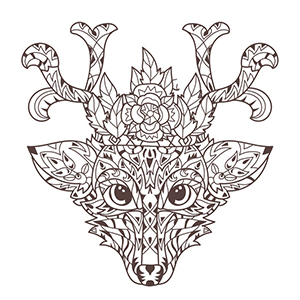
Here’s one of the Crowned Stag’s plays:
When you stand regal before someone, roll. On a 10+ hit, choose 3 of the following. On a 7–9 hit, choose 2. If there are more people here than one, decide whether your choices apply to one, some, or all of them.
• They must stop and take a step back from you.
• They bend a knee, reflexively.
• They may not speak, act, or depart until you give them leave.
• Invite them to come forward and address you. They must.
• Bid them welcome and to make free. Your hospitality now prevails here, for them, above any other law and custom.
On a miss, they must stop and take a step back, but then they’re free to act as they choose.
You might use this play to reveal yourself to someone, to withdraw from them, to rebuff them, or to change your relationship with them.
Here’s one of the Nightmare Horse’s plays:
When you disarm a situation, first disarm yourself, and then roll. On a 10+ hit, everyone else present must disarm themselves as well. On a 7–9 hit, everyone else present must individually choose: disarm themselves, or else insult you and everyone else here and declare themselves enemy to all. On a miss, after a moment’s hesitation you take your arms back up again.
You might use this play to reveal yourself to someone or learn more about them, but more importantly, notice how it takes the moment of conflict, which Apocalypse World would sharpen, and blunts it instead. It redirects the conflict away from a cycle of escalation, back into the game’s relationship cycle.
Here’s one of the Winding Rose’s plays:
When you lay your hand on someone, roll. On a 10+ hit, choose 2 of the following. On a 7–9 hit, choose 1.
• They will go with you where you lead.
• They forget what they were thinking about before.
• Their heart races, their breath comes ragged, and their head swims.
• They cannot remove your hand themself, but must wait for you do remove it.
• They trust you with what comes next, even after you’ve removed your hand, until you give them reason not to.
On a miss, choose 1 anyway, but you are beholden to them.
You might use this play to reveal yourself to someone, draw closer to them, or change your relationship with them.
Under Hollow Hills is coming out soon. Meanwhile, you can get a preview by looking over the play materials, here. I’ve only scratched the surface, but I think you’ll see what I’m talking about.
7. The Takeaway
The takeaway is, if you want to make a game that isn’t built on a model of conflict, you can and should!
Nothing easier. All you need is a different model.
8. Ursula LeGuin Says…
“Modernist manuals of writing often conflate story with conflict. This reductionism reflects a culture that inflates aggression and competition while cultivating ignorance of other behavioral options. No narrative of any complexity can be built on or reduced to a single element. Conflict is one kind of behavior. There are others, equally important in any human life, such as relating, finding, losing, bearing, discovering, parting, changing.
“Change is the universal aspect of all these sources of story. Story is something moving, something happening, something or somebody changing.
—Ursula K. LeGuin, Steering the Craft

And Remember…

The process of game design for me is intensely iterative: a first stab, then play & revise, play & revise, play & revise. Eventually, after enough iterative cycles, I can make a full draft. Then comes more play and revision as I take the game public, and only once all of those cycles are done do I go on to finish the game for release.
So this series is about only that first goal: to make something you can try. The rest of the process, the vast bulk of the process, we’ll have to take up another time.
I want to emphasize and re-emphasize: maybe, at the end of the iterative process, you have a PbtA game, or maybe you set PbtA aside somewhere along the way and come out with something else altogether. That’s FANTASTIC.
My goal is to get you into the iterative cycle. Whatever comes out of it, is up to you.
Thanks for reading!
Past Installments:
- Back in Part 1, I laid out Apocalypse World’s philosophy and foundation, described the fit and purpose of its systems, and talked about which features are central to its workings and which aren’t.
- Then in Part 2, I walked through the beginnings of taking Apocalypse World’s parts and using them as the basis for a whole new game.
- In Part 3, I dived back into Apocalypse World’s basic moves. I went through them one by one to talk about how and why they work the way they do.
- In Part 4, I talked about playbooks, by request. What are they, do you want them in your game, and what are the alternatives?
- In Part 5, I took a quick aside to talk about some different ways that moves can fit into the conversation of play.
Next Installments:
- Part 7’s a good old-fashioned Q&A, in rounds: Round 1, Round 2, Round 3 (the lightning round!), & Q&A Round 4 (the Final Round!)
- In Part 8, I share my six best, most reliable tricks for drafting interesting moves.
- In Part 9, I lay some groundwork for the idea of underlying models by pointing out a crucial feature of Apocalypse World.
- In Part 10, I develop the idea of underlying models further, with 2 solid examples and 1 tentative one.
- In Part 11, I explore a few of the dice systems we’ve used in our PbtA games.

Amicitia_NZ says:
This is a great article Vincent and lovely to see you using Ursula Le Guin as a springboard for this discussion. Le Guin is greatly missed and she was and remains a wise storyteller and human being. I learn something new from her every time I read Steering the Craft.
Theory review #3 – ropeblogi says:
[…] https://lumpley.games/2021/04/07/powered-by-the-apocalypse-part-6/ by Vincent Baker. About how a Powered by the apocalypse game need not be about conflict; an interesting subject, I would say, given how so many roleplaying games focus squarely on conflict and ignore the less forceful, even if more important, parts of being a human. […]
Comment jouer à des campagnes RPG sur table non violentes - Sird says:
[…] la partie 6 de leur série d’articles « Powered By The Apocalypse » sur jeux lumpley, Vincent Baker compare son jeu de règles Apocalypse World 2nd Edition avec les nouveaux RPG PBTA […]
[Q&A] Jay Dragon (Wanderhome) | The Hardboiled GMshoe's Office says:
[…] [12-May-21 08:25 PM] jdragsky#0001(citation: https://lumpley.games/2021/04/07/powered-by-the-apocalypse-part-6/) […]
Gordon says:
One of the great regrets of my life is that I saw (and technically “met”) Ursula K. LeGuin at a party and basically ran and hid rather than listen/talk to her. Stupid young me! So let me imagine a conversation following this quote:
Me: But conflict … change can always be viewed as a conflict, right? Change vs. Not Change, if nothing else. Right?
The Insightful Ms. LeGuin: I suppose so. But … why would you do that?
Jonah says:
I actually think you would be right, though.
I don’t think that every story can be reduced to a conflict, but conflict is so much broader as a concept than the relationship that one person has with someone else that they view as their enemy until proven otherwise. Conflict is conflict with the plot, with the world. It’s uncertainty and the possibility of a loss, no matter how small or subjective; indeed, most conflict is, frankly, internal. Do I turn left or do I turn right? That is a conflict!
In other words, yes, a story where someone is uncertain whether they want to change is absolutely a story with conflict! It’s the conflict between two ideas that they have. That’s why we say that people are “conflicted” about changing. Only a story where someone never doubts whether they want to change, or where no change occurs at all, lacks that kind of conflict, and I think such stories are rather uncommon.
I read Le Guin’s works extensively when I was writing about her for my literature class, and with the possible exception of some of the most large-scale, anthropological stories in Changing Planes, I remember every story I read having some kind of conflict: usually even interpersonal, but at the very least, conflict between two conflicting ideas that a single person held. I would agree with her, granted, that conflict alone cannot make for a good story, but it certainly seemed as if she employed it very consistently.
Peacefully Revoking Consent To Be Governed For You And For All says:
Finding out about Under Hollow Hills tonight has suggested to me I’m meant to ask you a question. Here’s why:
The person I’m partnering with conceived a child, who we gave the last name All to, with the idea of one day changing our last names to All. Thus, Uni Verse All came to this realm. I legally changed the name the system knows me by to Peacefully Revoking Consent To Be Governed For You And For All. The person I’m partnering with is experimenting with Annette To Break Our F All. We’ve trying to figure out what to do with this apocalypse world we’ve all found ourselves in. Two days ago, I found the playbooks for Apocalypse World under a pile of things and reread them. After reading one, I decided to build my own character using as many playbooks/moves necessary to model who I am in real life and who I want to become. Today, it occurred to me I could also model the real world, present the story from the real world to viewers on twitch.tv, as well as the playbooks/moves/sheets for me, and then be the collective audience’s PC. This is one possible future. A parallel one Annette & I have been contemplating is somehow acquiring an RV and going around the country as a traveling circus…All Family Circus. The first show’s current idea is 3 acts: triggering/confronting childhood trauma and healing through it, triggering/confronting present trauma and healing through it, and envisioning the future from whatever the resulting perspective is. We currently call it Apocaellipsis…
Also, I’ve been concocting ideas to build and live in a hobbit hole of sorts for 20+ years. The latest desire along these lines has been to get a 3d printer to make buildings like these along the tour route: https://www.fastcompany.com/90619146/this-wild-looking-house-is-made-out-of-dirt-by-a-giant-3d-printer
With all this in mind, finding out about a thing called Under Hollow Hills, which is about a traveling circus of magical people focusing on play, healing, and change, led me to this question:
What if we explore designing and playing this stuff into real life together?
Myles says:
Is this all real?